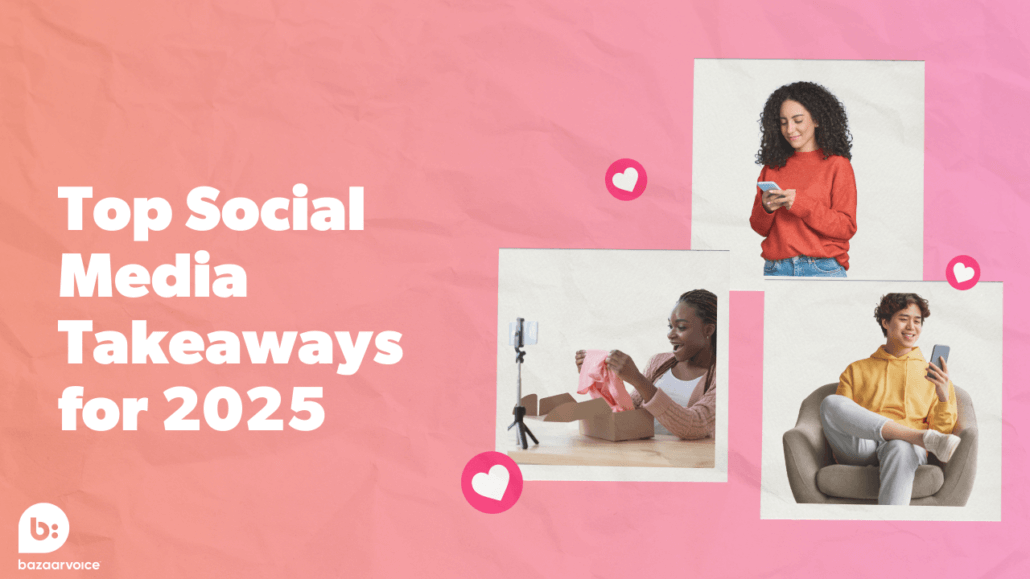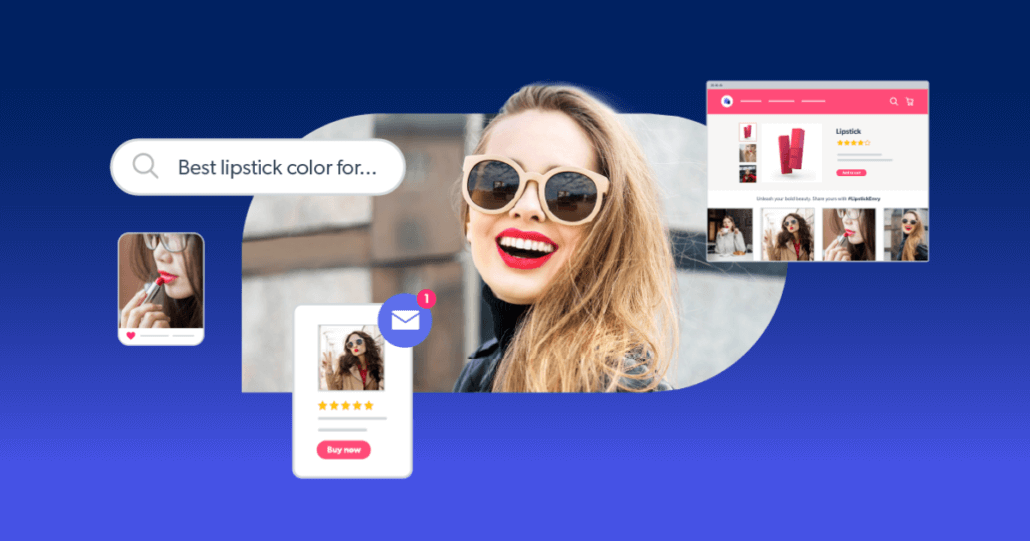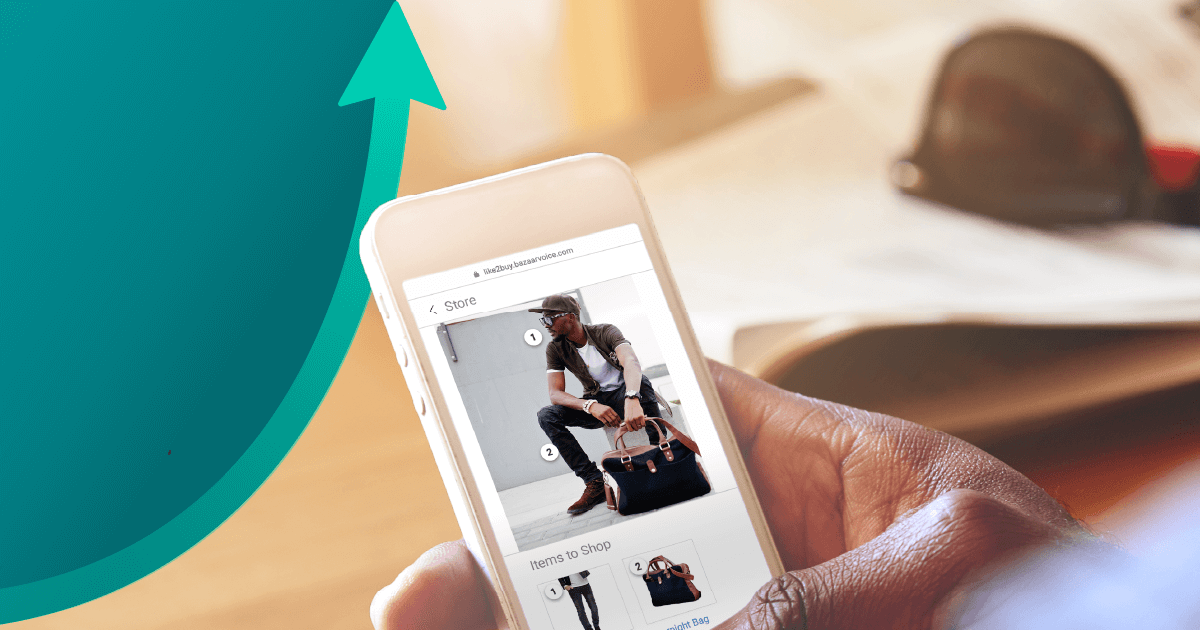November 16, 2023
Online shopping is a growing market, and the numbers back it up: By 2027, worldwide e-commerce business sales are gearing up to cross the $8 trillion mark. However, online consumers aren’t shopping the same way — or spending the same amount — that they do in retail stores. This is increasingly true as online shopping has evolved to now occur on social media too.
At the point of discovery, when online shoppers stumble upon a great find, they’re more likely to simply research the item, not purchase it. Shoppers primarily use shop tags on social media to learn about a product, according to Bazaarvoice research. Only 25% of consumers actually use those tags to make an immediate purchase.
This illustrates that there’s a disconnect between how people shop online and how brands force them to do so. While the internet has no shortage of products available for purchase, brick-and-mortar retail stores have a significant advantage over e-commerce: They’re designed for discovery shopping. However, your e-commerce brand can grow engagement and sales by implementing discovery shopping. Keep reading to learn how.
The e-commerce discovery problem
If you’ve ever visited a store just to browse and left with a cute sweater, a useful gadget, or bags of impulse items you just had to have, you’ve engaged in discovery shopping. This is the act of shopping for entertainment or without knowing what you’re looking for — and you’re certainly not alone. By some estimates, discovery shopping accounts for about half of the retail market.
But that’s not the case online. Why? Because the way most e-commerce stores are set up makes discovery shopping difficult for the following reasons.
E-commerce is designed for conversions — not discovery
Most e-commerce sites are made to be transactional. They may employ tools like product reviews to help validate your purchasing decisions, or they may offer up product recommendations to introduce you to other items. However, this is typically done in a restrictive fashion because e-commerce sites are designed primarily to convert. They’re set up to help you find exactly what you’re searching for and to get you to make a purchase as quickly as possible.
But when we shop in a retail environment, this isn’t the case. In stores, we wander through aisles, see thousands of products simply by looking around, and can interact with these items — touch them, read their tags, try them on — easily.
Shoppers often end up spending more time and money in brick-and-mortar stores rather than online ones due to the way they’re physically set up. This type of experience is challenging to create in e-commerce because of the limitations of UX and because there are simply so many items to represent digitally. Also, these sites are typically built from catalogs, which contain product information and detail photos — but not lifestyle content.
In other words, most e-commerce sites don’t provide consumers with the shopping experience they crave because the sites don’t invite shoppers to browse and discover the same way they do in stores.
This experience is easier to create on social, though, because of the engaging lifestyle content we find there. And e-commerce sites can bridge this gap and give consumers what they want by simply tagging lifestyle imagery with product metadata.
Social media can’t get the job done alone
Social media is leading the way in doing this, and it’s starting to change e-commerce as a result. Discovery on social is growing, with nearly 80% of shoppers saying they’ve discovered a new product on social media.
Instagram launched shoppable photos in 2016 which began to change the way brands thought about marketing and sales within the realm of social media, especially on mobile.
But simply making social shoppable isn’t the solution. Research shows that nearly 50% of consumers who purchase a product they discover on social media buy it online at a later date. However, nearly as many people buy an item in a retail store (13%) as people who buy it immediately (19%). This indicates that merely allowing people to purchase directly from social isn’t enough to prompt a purchasing decision.
Bazaarvoice takes this shopping experience a step further, though. Customers are able to easily explore items featured in photos and make purchases. It’s essentially an Instagram storefront that lets users scroll, shop, and be inspired. Plus, it engages consumers at the point when their interest in a product — and their excitement for it — is at its peak (this is huge).

When we scroll through photos and videos shared by brands, influencers, friends, and acquaintances, we may see something that catches our eye — a pair of shoes, a piece of jewelry, a kitchen gadget, you name it — and there’s that familiar spark of discovery we experience in a retail environment.
And product discovery on Instagram has had the most growth among social sites, with 48% of consumers finding products there, up from 18% in 2017. But other social sites have also experienced a growth in discovery among shoppers:
- Facebook has gone from 52% to 70%.
- Twitter has gone from 17% to 32%.
- Pinterest has gone from 22% to 29%.
This discovery element is key — and it’s possible because social is so focused on visuals versus traditional e-commerce sites, which are focused on fitting an entire product catalog online.
But while social media may inspire consumers, scrolling through lifestyle content on Instagram alone doesn’t create that discovery-shopping experience for the consumer. With the introduction of shoppable social content, it’s getting closer. You no longer have to interrupt the flow of photos to direct a customer to your account bio and ask them to click a link — but it’s still not quite there.
Luckily, there’s a better way to give shoppers the experience they want. It involves bringing social and commerce together.
Social commerce solves the discovery problem
Brands can provide customers with the discovery-shopping experience they crave — and they already have the tools to do it. It’s called social commerce.
Social commerce has become synonymous with “making Instagram shoppable,” according to Apu Gupta, VP of Social Content Revenue at Bazaarvoice. However, there’s much more to it than that. It involves providing consumers with the same discovery thrill they experience in retail stores. Here’s how.
Social commerce enables consumers to discover new products
Traditional e-commerce is optimized for people who know what they want: they enter a search term, and related results are returned.
However, on social, the purchasing journey begins not with a search, but with a scroll. Bazaarvoice capitalizes on this by using inspirational lifestyle and user-generated content (UGC) to introduce people to products they never knew existed.
“By offering UGC, customers have content to engage with, and it means that they can do as much research as they want about us, as a brand and about the products. We’re giving them more ways to engage with us and I think that’s the most exciting part for us,” said Eleanor Assa, CMO at Iconic London.
Social commerce helps sellers understand use cases
Seeing products in real-world environments helps online shoppers understand how to style, arrange, and use products, which can entice them to click “add to cart.”
Plus, this type of content provides confidence around purchasing because consumers can see how real people are already using the products in their daily lives.
“Bazaarvoice Social Commerce has been a great addition for us. We have many customers buying online, and being able to visualize our bed frames and peripheral ranges like sofa beds and furniture in real customers’ homes is really useful [for them],” explains Octavia Benham, Head of E-commerce at Dreams.
Social commerce establishes connections
Content that catches the consumer’s eye and invites them to sit back and browse provides a sense of connection between the consumer and the brand. It helps shoppers understand the community and lifestyle behind a retailer and fosters that relationship.
“Being able to show MAM’s designs, colors, and trends when people couldn’t actually go to the store was particularly powerful. For us, Social Commerce was just another great opportunity to showcase what MAM’s all about,” said Daniel Smith, National Account Manager at MAM.
And these relationships are important to companies’ bottom lines. In fact, 65% of brands’ business comes from existing customers.
How to get great content for social commerce
The key to inviting customers to spend time with your brand online and browse its products is, of course, great content. Here’s how you can use tools to inspire a sense of commerce discovery in consumers.
Create content that’s tailor-made for social
It’s simple to find, make, and share shoppable social content with Bazaarvoice. From your dashboard, you can identify influencers, access brand content from real users, and even automatically tag products for social sharing.
Essentially, you can create your social content in one place and make it a breeze for customers to shop directly from your Instagram bio.
Work with influencers to generate content
Influencers are incredibly valuable for increasing your brand’s reach and getting your products in front of consumers. While it’s relatively easy to identify macro influencers and celebrity influencers with mega followings, consider that they’re seen as less influential
According to a recent Bazaarvoice influencer communities study, only 12% and 6% of shoppers report they’re likely to be influenced to purchase a product from these influencers, respectively. And recent research tells us that consumers are increasingly leaning more into nano- and micro-influencers.
Nano-influencers can have as few as 2,500 followers, but not only is it more affordable to work with smaller influencers (with 69% of marketers saying they’re working with them) — they also have greater impact than celebrities when it comes to engaging consumers and inspiring them to make a purchase. In fact, 86% of shoppers buy based on nano- and micro-influencer recommendations.
Take advantage of UGC
Customers are proud of their brand associations and are already tagging brands in posts and using brand-associated hashtags. Why not take advantage of this?
“In the same way stores represent the fabric of a neighborhood, we wanted to create areas like our blog, like our social media presence, that create online communities where people could look for inspiration, where people could see real people buy,” says Parachute Home CMO Luke Droulez. “That this is meant [as] accessible luxury without saying those words.”
3 ways your can brand can implement shoppable social content
There’ are’s several ways brands can foster discovery in e-commerce, inspire consumers, and invite them to sit back and browse.
1. Add shoppable Galleries to your website
Adding a gallery of shoppable photos to your website not only allows consumers to seek inspiration and discover new products, but it also has measurable effects. We find that brands incorporating on-site Galleries see on average a 140% conversion rate lift, a 15% increase in average order value, and a 308% increase in time on site.
Take natural beauty brand The Body Shop, for example. To drive conversions, the retailer used Bazaarvoice to create its #TheBodyShop gallery on its product detail pages. By showcasing authentic photos and videos shared by their dedicated brand loyalists, customers were urged to post their experiences, bridging the gap between online browsing and the tangible in-store experience.
“Galleries was a big win for us. Bigger than anyone expected. We set out to fully utilize our social content to drive engagement and use it as a tool to educate customers through their purchasing decisions. We want customers to understand what our products are about, beyond ratings and reviews; we want them to see the actual products and their benefits through the experiences of real customers,” said Indar Chanicka, VP of E-Commerce at The Body Shop.
2. Create a truly shoppable Instagram
While Instagram’s visual focus makes it a great place to find products, it’s a lot like window shopping. Oftentimes, you can view a product, but you can’t learn more about it nor take further action.
But with Like2Buy, brands can transform their Instagram feed into an actual shoppable storefront. Customers can then click on products, learn more about them, read reviews, see photos of real customers wearing or using the product, and even make a purchase.
3. Implement UGC on all touch points
UGC is more influential than brand-created content for good reason — it showcases actual customers using products, it’s more authentic and establishes trust among consumers, and this makes it more engaging. In this current economic environment, one-third of shoppers rely more on UGC than branded content.
That’s why companies like Parachute have implemented UGC in all aspects of their marketing, including emails and retargeting ads.
By utilizing Bazaarvoice’s tools, these brands have been able to find high-quality UGC from customers who are already fans of their products. Brands can then easily implement this customer-created lifestyle content everywhere from social feeds to product pages.
Social content creates better browsing experiences
Consumers are increasingly turning to Google Images to begin their shopping-related searches. This shows us that consumers are after a more traditional shopping experience of browsing and discovery even when they’re online. They’re not stumbling upon great finds by reading search results or scrolling through category pages of e-commerce sites. They’re looking for visuals and they want to see social content that shows products being used and enjoyed in real ways by real people.
To provide consumers with this authentic shopping experience, brands need to create a retail experience that invites shoppers to browse. They need to inspire consumers to stop scrolling and take a second look.
And to do this, the online shopping experience needs to be just as visual and discoverable for people online as it is in brick-and-mortar stores — and social commerce is the secret sauce.










